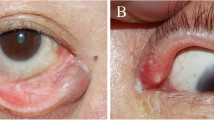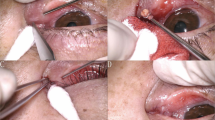Abstract
Purpose
The treatment options for canalicular obstruction remain controversial, and there are different approaches. In this study, we aimed to evaluate the success of balloon dilatation and silicon tube intubation according to the etiology in patients with canalicular obstruction.
Methods
The files of 91 patients with isolated monocanalicular obstruction were retrospectively reviewed. Patients were grouped according to surgical methods (Group A: both balloon dilatation and silicon tube intubation; Group B: Only balloon dilatation) and etiologies (topical anti-glaucomatous usage-related, inflammatory, chemotherapy-related, radiotherapy-related, trauma-related, idiopathic). Preoperative and postoperative Munk scores and lacrimal irrigation results were noted in all cases.
Results
Munk score was found to be statistically significantly lower in the 1st year in both groups. The patency rate with lacrimal syringing was found to be statistically significantly higher in group A. Success rates both in the munk score and lacrimal passage patency were found to be statistically significantly lower in inflammatory etiology than other etiologies.
Conclusions
Both techniques can be used as first-line therapies for canalicular obstruction. It should be considered that recurrence may develop in stenosis of inflammatory origin and more invasive surgery may be required.
Similar content being viewed by others
References
Nemet AY (2016) The etiology of epiphora: a multifactorial issue. In: Seminars in ophthalmology. Taylor & Francis
Schaefer DP (2015) Acquired etiologies of lacrimal system obstructions. The Lacrimal System: Diagnosis, Management, and Surgery, Second Edition, pp 43–68
Fiorino MG, Quaranta-Leoni C, Quaranta-Leoni FM (2021) Proximal lacrimal obstructions: a review. Acta Ophthalmol 99(7):701–711
Steele EA (2016) Conjunctivodacryocystorhinostomy with Jones tube: a history and update. Curr Opin Ophthalmol 27(5):439–442
Quaranta-Leoni FM et al (2021) Management of proximal lacrimal obstructions: a rationale. Acta Ophthalmol 99(4):e569–e575
Sipkova Z et al (2017) Assessment of patient-reported outcome and quality of life improvement following surgery for epiphora. Eye 31(12):1664–1671
Zoumalan CI et al (2010) Balloon canaliculoplasty for acquired canalicular stenosis. Ophthalmic Plast Reconstr Surg 26(6):459–461
Singh M et al (2022) Long-term outcomes of lacrimal canalicular trephination with viscoelastic-assisted monocanalicular stenting for canalicular obstructions. Roman J Ophthalmol 66(1):41
Ushio M et al (2022) Conjunctivoductivo-dacryocystorhinostomy: a novel surgery for intractable canalicular obstruction. Laryngoscope 132(4):728–731
Janjua TA, Akbar B (2019) Anterograde reconstruction of severe bi-canalicular obstruction with autogenous saphenous vein graft: a novel surgical technique. J Coll Phys Surg Pak 29(5):481–482
Park J, Kim H (2015) Sequential probing and dilatation in canalicular stenosis. Graefes Arch Clin Exp Ophthalmol 253(11):2007–2013
Liarakos VS et al (2009) Management of canalicular obstructions. Curr Opin Ophthalmol 20(5):395–400
Chen D et al (2012) A novel procedure for treating canalicular obstruction by re-canaliculisation and bicanalicular intubation. Br J Ophthalmol 96(3):366–369
McNab AA (1998) Lacrimal canalicular obstruction associated with topical ocular medication. Aust N Z J Ophthalmol 26(3):219–223
Everman KR et al (2012) Canalicular obstruction: a histopathologic case series. Can J Ophthalmol 47(6):500–503
Tabatabaie SZ et al (2012) Randomized study comparing the efficacy of a self-retaining bicanaliculus intubation stent with Crawford intubation in patients with canalicular obstruction. Clin Ophthalmol 6:5
Schmid KE et al (2006) Update on ocular complications of systemic cancer chemotherapy. Surv Ophthalmol 51(1):19–40
Mansur C, Pfeiffer ML, Esmaeli B (2017) Evaluation and management of chemotherapy-induced epiphora, punctal and canalicular stenosis, and nasolacrimal duct obstruction. Ophthalmic Plast Reconstr Surg 33(1):9–12
Sharma A, Pattnaik M, Ali MJ (2021) A rare case of pemetrexed-induced diffuse punctal and canalicular stenosis: management by coronary balloon puncto-canaliculoplasty. Orbit, pp 1–3
Satchi K, McNab AA (2019) Idiopathic acquired lacrimal canalicular obstruction. Ophthalmic Plast Reconstr Surg 35(3):266–268
Funding
The authors declare they have no financial interests.
Author information
Authors and Affiliations
Contributions
Conception or design of the work: AA , TY and MO. Data collection: AA and MT. Data analysis and interpretation: AA and MO. Drafting the article: AA and MT. Critical revision of the article: TY and AA.
Corresponding author
Ethics declarations
Conflict of interest
The authors declare no conflict of interest.
Additional information
Publisher's Note
Springer Nature remains neutral with regard to jurisdictional claims in published maps and institutional affiliations.
Rights and permissions
Springer Nature or its licensor (e.g. a society or other partner) holds exclusive rights to this article under a publishing agreement with the author(s) or other rightsholder(s); author self-archiving of the accepted manuscript version of this article is solely governed by the terms of such publishing agreement and applicable law.
About this article
Cite this article
Ağaçkesen, A., Yazıcıoğlu, T., Oklar, M. et al. Importance of etiology in canalicular obstruction surgery. Int Ophthalmol 43, 3193–3198 (2023). https://doi.org/10.1007/s10792-023-02719-w
Received:
Accepted:
Published:
Issue Date:
DOI: https://doi.org/10.1007/s10792-023-02719-w




